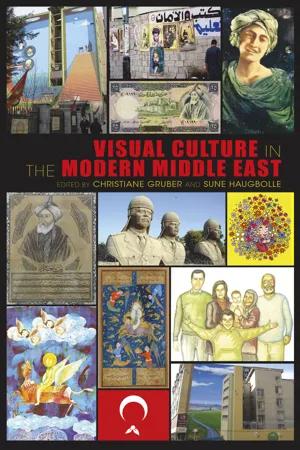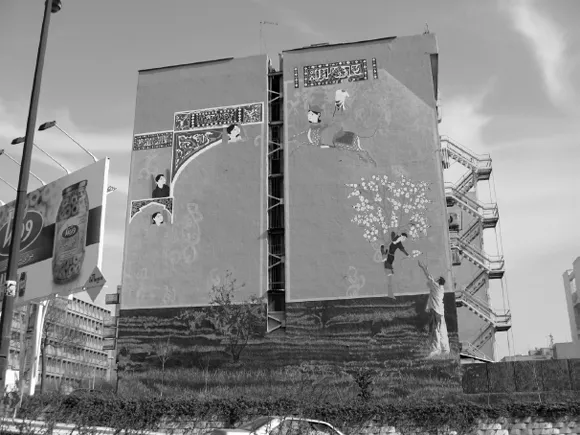![]()
PART 1
“Moving” Images
![]()
FIGURE 1.1. Mural of Muhammad’s ascension, located at the intersection of Modarres and Motahhari Avenues, Tehran, Iran, 2008. Author’s photograph, 2010.
CHAPTER 1
Images of the Prophet Muhammad In and Out of Modernity: The Curious Case of a 2008 Mural in Tehran
CHRISTIANE GRUBER
A colorful mural appeared at the busy junction between Modarres Highway and Motahhari Street in central Tehran in 2008, gracing the wall of an otherwise unremarkable five-story cement building (fig. 1.1 and plate 1). This mural does not depict what one would expect to see in Iran’s post-revolutionary mural arts program: Ayatollahs Khomeini and Khamenei or the portrait of a martyr who died in the Iran–Iraq War (1980–88). These other mural subjects, which have graced and given meaning to the capital city’s urban landscape over the past thirty years, represent a genre of public portraiture that stresses both the Islamic Republic’s Shi‘i-Persian identity and governance and the duty of all Muslims, both at home and abroad, to sacrifice themselves to a greater cause by fighting and dying in war.1
Casting aside such overt iconographies and messages, as is the case with many other large-scale paintings currently appearing on cement walls throughout Iran,2 this mural instead depicts the Prophet Muhammad on the night of his heavenly ascension (mi‘raj).3 Depicted in an Islamic painterly style, Muhammad is shown wearing a green cloak with his arms folded at the waist, as he sits on his human-headed flying steed named Buraq. While Buraq bears delicate facial features, Muhammad’s visage has been left blank but is nevertheless framed by his other prophetic attributes: his black tresses, white turban, and flaming gold nimbus. He ascends the skies, leaping through tiled archways that are decorated with epigraphic bands and guarded by disembodied angels who hover in midair.
The scene does not halt here. In the mural’s lower right corner, a young and beautiful inhabitant of paradise, most likely a “bright-eyed” huri, climbs a tree that grows in a fertile valley of grass. From that tree, the huri picks a cluster of flower blossoms and hands it to a man who stretches his arms out to receive the offering. This man is perhaps a deceased soul being welcomed into the Garden of Eden, which Muhammad witnessed and visited on the night of his ascension. The young man wears modern and rather hip clothing; in fact, he could be any Iranian youth strolling through Tehran’s streets and parks. Painted in repoussé with his back to the viewer and depicted in a photorealistic style, the figure has indiscernible facial features, suggesting that he represents a type rather than an identifiable individual. Judging from the traditional emphasis afforded to martyrs within Tehran’s mural arts program since 1979, this type is most likely the martyr (or the martyr in potentia), that is, the corporate stand-in for individuals willing to perish for state-and-religion or in the “way of God” (fi sabil Allah), whose final reward is none other than paradise.
So what is one to make of this contemporary mural, its double mi‘raj-martyrdom thematic, and its blending of old and new pictorial styles? What is its larger significance for understanding the diverse roles images play in the artistic traditions and visual culture of Iran today? And what does this mural tell us about figural representation and, more specifically, how a powerful icon such as the Prophet Muhammad can become a point of cultural contention or a symbolic pivot for the politics of identity on a global scale after the Danish cartoon controversy of 2005–2006?
This study aims to offer preliminary answers to these questions by focusing on this recent ascension mural in Iran, as well as on images of the Prophet in both Islamic spheres and European contexts. In particular, my aim is to determine how this particular mural engages with Iranian discourses that touch upon issues of tradition, identity, and belonging, while also advancing such claims within the complex cultural circuits and volatile religious entanglements of the post–9/11 world. In exploring the many issues raised by this one mural—the only of its kind to represent the Prophet Muhammad, openly and proudly, in a physical space in a Muslim-majority country—it is clear that contemporary images navigate the past and present tenses, local and global spheres, and real and virtual space. Much like sharp rhetoric, moreover, images like the ascension mural can act as powerful purveyors of ideologies and ontologies, because they likewise make arguments about knowledge and stake positions concerning truth and reality.
Indeed, besides manifestly discarding clichéd statements that Islam putatively prohibits figural imagery, especially representations of the Prophet Muhammad,4 this ascension mural advances specific arguments while also staking several positions. Its arguments include promoting, first, the utmost rank and legitimacy of the Prophet Muhammad, who was invested by God with prophecy and knowledge of the otherworld on the night of his mi‘raj; second, the transcendental beauty of Muhammad in the aftermath of the desecration of his image in the dozen satirical cartoons published in the Danish newspaper Jyllands-Posten in 2005; and third, the supreme value of fighting, and possibly dying, for a cause that is couched as being “in the way of God.” In brief, the mural seeks to reclaim the Prophet Muhammad and his blessed beauty for the Islamic community by mounting a visual counterattack.
This “striking back” is ipso facto the mural’s position, which is one that carefully harnesses an Islamic artistic past, editing its main features and rearticulating them to promote Iran’s religio-national messages in today’s global world. While navigating both the past and present, Islamic and non-Islamic discourses, this mural essentially stakes a Shi‘i-Persian stance of opposition and resistance, thereby offering an imaged repartee to what the Iranian regime perceives as demeaning hegemonic discourses on Muhammad and the Islamic faith in various media outlets, especially those stemming from the Euro-American, Christian “West.”
In other words, this mural helps carve out a number of salient paths of critical inquiry in order to better understand visual culture as it takes shape within a specific modern Muslim context that willfully seeks to intersect with the politics of identity on a global scale. It also serves as a heuristic device for tracking public discourses on self and other, while at the same time functioning as a barometer for religio-cultural contestations within image-making traditions (and industries) in Iran and beyond. Perhaps more germane for the broader field of visual culture, moreover, this mural functions as a symbol that partakes in the deep semantic codes of a culture, thereby generating new discursive fields of meaning configured not through verbalized but rather visualized signs. As W. J. T. Mitchell would note, this mural indeed demands “equal rights with language,”5 thereby inviting us to engage in interpretative acts of the visual via its various signifying systems and expressive cultures.
Tangled Skeins
The mural’s artist, a female M.F.A student at Tehran University named Faezeh Rahmati, won the competition launched by Tehran’s municipality (shahrdari) in 2008. The municipality’s program on murals, fitted within its Bureau of Beautification (sazman-i zibasazi), selected her composition to adorn the blank side of the building, centrally located at the intersection of Modarres and Motahhari Avenues.6 Before 2008, this building boasted a highly visible, large-scale banner of the Palestinian suicide bomber Rim Salah al-Riyashi (d. 2003), itself a duplication of a photograph taken immediately prior to her death. In the banner, this female martyr is shown holding her son and a rifle, exclaiming that she loves martyrdom more than motherhood.7 For reasons that are unclear—to beautify the city? to remove an overtly martyrial message?—this worn-out banner was pulled down to make way for the ascension mural.
Once denuded of the banner, the building’s empty wall was adorned with the more muted mi‘raj scene, which the artist Rahmati entitled A Bouquet of Flowers from the Ascent (Dast-i Gul az ‘Uruj).8 Thus, a contemporary black-and-white photograph of a female martyr ceded way to a vibrantly colored illustration of Muhammad’s ascension, executed in a “classical” Islamic book arts style.
The mural’s “classical” iconographic sources are easily identifiable. The artist admits that she drew upon and selected a series of scenes belonging to the famous Timurid illustrated manuscript of the Mi‘rajnama, or Book of Muhammad’s Ascension, that was produced in the city of Herat around 1436 ce (figs. 1.2–1.4). Boasting more than fifty paintings of Muhammad’s ascension through the heavens, his encounter with prophets and God, and his visits to heaven and hell, this manuscript, held in the Bibliothèque nationale de France in Paris, is without a doubt a rare and stunning masterpiece of Islamic art. As such, it is frequently included in surveys of Islamic painting. Additionally, it also has been the subject of two studies, a handbook of illustrations prepared by Marie-Rose Séguy (in French, 1972; reissued in English, 1977) and a monographic study by the present author (2008).9 Séguy’s handbook was translated into Persian and published in 2006 under the title “Book of Ascension: The Miraculous Journey of His Majesty the Prophet” (Mi‘rajnama: Safar-i Mu‘jiza-i Asa-yi Payghambar). This Persian edition has since been displayed in the vitrines of academic bookstores lining Engelab Avenue, whence it served to inspire a number of publications, conferences, and art projects by scholars, students, and artists at Tehran University. Thus, Rahmati’s mural is based on an Islamic fifteenth-century illustrated manuscript of Muhammad’s ascension, made available via a handbook of its illustrations as published in a widely popular 2006 Persian edition.
This rather uncomplicated artistic and scholarly stemma notwithstanding, a few “technical” issues make this Book of Ascension manuscript more difficult to untangle. The manuscript’s provenance, language, script, and pictorial language are, like the proverbial Gordion knot, almost intractably problematic, especially considering its reception and adaptation within a contemporary Iranian public mi...

